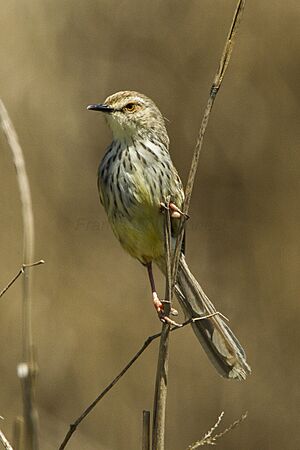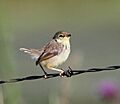Drakensberg prinia facts for kids
Quick facts for kids Drakensberg prinia |
|
|---|---|
 |
|
| Conservation status | |
| Scientific classification | |
| Genus: |
Prinia
|
| Species: |
hypoxantha
|
The Drakensberg prinia is a small passerine bird that lives in eastern South Africa and Eswatini. It is also known as the saffron-breasted prinia. You can often find this bird in the beautiful Drakensberg mountains. It likes to live near the edges of forests, in wooded valleys, and on slopes covered with bracken plants.
Contents
What Does the Drakensberg Prinia Look Like?
This little bird is about 12 to 14 centimeters long. That's roughly the length of a pen! It has short, rounded wings and a fairly long tail. Its legs are strong, and it has a short, straight black beak.
Feathers and Colors
The Drakensberg prinia has a whitish stripe above its eye, like an eyebrow. Its back and upper parts are brown. The throat and lower part of its face are whitish, without any stripes. The rest of its tummy and chest are yellowish with some dark stripes. Its long tail has a dark spot near the end and is usually held up at an angle. The bird's feet and legs are pinkish-brown, and its eye is pale.
Boys and Girls
Both male and female Drakensberg prinias look the same. Young birds, called juveniles, are a bit paler on their undersides than the adult birds.
What Sounds Do They Make?
These birds have some interesting calls! You might hear a sharp chleet-chleet-chleet-chleet-chleet-chleet. They also make a fast, buzzy sound that goes tit-tit-tit-tit-tit.
How Do Drakensberg Prinias Behave?
The Drakensberg prinia is a busy little bird. It usually hangs out in pairs or small groups. They often stay low in bushes and shrubs, but sometimes you'll see them perching on top of a bush.
Finding Food
These birds are very active when they look for food. They mostly eat small insects. As they search, they often hold their tail cocked up and swing it from side to side.
Building a Home
When it's time to build a nest, the Drakensberg prinia creates a thin-walled, oval-shaped home. It has an entrance on the side. They build their nests from green grass and hide them very well deep inside a leafy shrub or bush. This helps keep their eggs and chicks safe.
Is the Drakensberg Prinia Safe?
Good news! The Drakensberg prinia is a common bird. It lives across a very large area, estimated to be between 50,000 and 100,000 square kilometers. There are many of these birds, so their population is considered large and healthy. Because of this, experts believe the species is not in danger. It is listed as "least concern" on the IUCN Red List, which means it's not close to becoming endangered.
Images for kids






